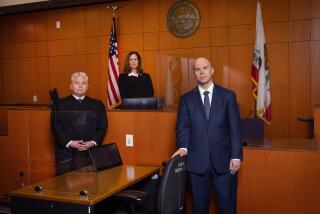Audit finds $30 million in ‘questionable’ court spending and salaries
California’s court leaders spent $30 million over four years on “questionable” expenses and salaries, leaving less money for cash-strapped trial courts, a state audit said Wednesday.
The audit, ordered by the Legislature, called on the court’s statewide leadership to more closely supervise the hundreds of employees that administer the court system. The Judicial Council, the policymaking arm of the courts, oversees what until this year was called the Administrative Office of the Courts, or the AOC.
“This report concludes that questionable fiscal and operational decisions by the Judicial Council and the AOC have limited funds available to the courts,” State Auditor Elaine M. Howle wrote in a letter to Gov. Jerry Brown and state lawmakers who requested the review.
Chief Justice Tani Cantil-Sakauye, who heads the Judicial Council and appoints most of its members, established a group Wednesday to study the audit and make recommendations to the council.
“I believe every organization should constantly reassess and continuously improve itself,” Cantil-Sakauye said.
The “questionable” spending cited by auditors would not have made much of a dent in a funding shortfall that has left courts across the state staggering just to stay open and provide services to the public.
The $30 million over four years amounted to less than 1% of total spending on courts during that time, Judicial Council staff said. By contrast, the courts lost about $1 billion in state funding during those years.
But the specter of waste was likely to hinder the efforts of court leaders to persuade the Legislature and Brown to restore funds. The cuts have caused widespread delays in getting legal matters resolved.
“Thirty million dollars is an alarming sum of money,” said Judicial Council Administrative Director Martin Hoshino. “For the average citizen in tough economic times and for our frugal governor, it is not OK. Every nickel and dime adds up.”
Auditors found the administrative office paid eight of its nine office directors more than $179,000 a year, which is higher than the salary for the governor and his top administration staff, who “have much broader responsibilities.”
Hoshino, hired three months ago to run the San Francisco-based 800-employee agency, is the top earner, with an annual salary of $227,000. The governor earns $177,000 a year, less than the justices he appoints to serve on the California Supreme Court and less than is earned by some county court administrators.
The average salary for the administrative office’s employees was about $82,000, “while salaries in the executive branch average $62,000 and those in four large trial courts average $71,000,” the audit found.
It recommended a thorough review of compensation practices, including an end to paying employees’ share of retirement contributions.
Auditors also said the Judicial Council could save $5 million in rent each year by moving its San Francisco and Burbank offices to Sacramento, where rents are cheaper.
Cantil-Sakauye has said such a move would be too disruptive, though it would personally benefit her. The administrative office is in a state-owned building that also houses the California Supreme Court and the 1st District Court of Appeal.
Cantil-Sakauye’s primary residence is in Sacramento. She purchased a condominium in San Francisco to be close to the court and its administrative offices during the workweek. The California Supreme Court has been based in San Francisco since the late 1800s.
Still, the auditors said consolidation in Sacramento would save travel and salary costs. One administrator spent $22,000 traveling between offices over three years, the audit said.
The audit also questioned why the administrative office maintained a fleet of 66 vehicles across the state without documenting their necessity.
A dissident group called the Alliance of California Judges had lobbied for the audit. For years the organization has complained that the administrative office was spending recklessly while the trial courts were barely scratching by.
“The Judicial Council has lost touch with its primary mission of advising the courts and has instead morphed into an over-bloated bureaucracy that places its own interests ahead of those of the trial courts it was created to serve,” the alliance said in a statement Wednesday.
The budget for the administrative office amounts to 4.1% of annual spending for the entire court system, according to Judicial Council staff. A spokesman said the office has been cut by 30% over the last several years.
Unions for court workers also had lobbied for the report. The Service Employees International Union of California said the audit confirmed mismanagement by administrators.
“As California turns a fiscal corner and begins to reinvest in our financially devastated trial courts, it is imperative that the Legislature demand improved accountability and transparency to restore taxpayers’ trust in the judicial branch and ensure the timely access to justice that is at the heart of a civil society,” Debbi Pearson, an Alameda County Superior Court worker, said in a statement released by the union.
The auditors said they did not find any reserves or contingency funds that the administrative office could provide the trial courts.
Cantil-Sakauye said the audit had some “useful recommendations” and noted that an earlier investigation she ordered into the operations of the administrative office had made similar suggestions, which the council has been implementing.
“This audit, while confined in scope, gives us another useful tool to help us make progress,” she wrote in a letter to court personnel Wednesday.
Twitter: @mauradolan
Twitter: @mcgreevy99
McGreevy reported from Sacramento, Dolan from San Francisco.
More to Read
Start your day right
Sign up for Essential California for news, features and recommendations from the L.A. Times and beyond in your inbox six days a week.
You may occasionally receive promotional content from the Los Angeles Times.








